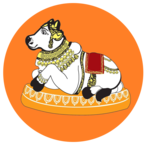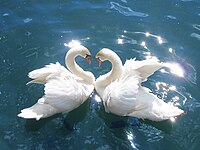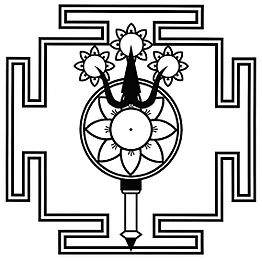Kashmir Shaivism

| Part of a series on |
| Shaivism |
|---|
 |
|
Deities Paramashiva (Supreme being) |
|
Scriptures and texts |
|
Philosophy
|
|
Practices |
|
Schools
Saiddhantika Non - Saiddhantika
|
|
Related |
Kashmir Shaivism is a group of nondualist Tantric Shaiva exegetical traditions from Kashmir that originated after 850 CE.[1] The term Trika was used by Abhinavagupta to represent the entire Kashmir Shaivism or to designate the Pratyabhijna system and this was actually pan-Indian, also flourishing in Oḍiśā and Mahārāṣṭra.[2][3]
The Tantrāloka, Mālinīślokavārttika, and Tantrasāra of the Kashmirian Abhinavagupta (975–1025 CE) are formally an exegesis on the Mālinīvijayottara Tantra, although they also drew heavily on the Kali-based Krama subcategory of the Kulamārga.[4]
Kashmir Shaivism claimed to supersede Shaiva Siddhanta, a dualistic tradition which scholars consider normative tantric Shaivism.[5] The Shaiva Siddhanta goal of becoming an ontologically distinct Shiva (through Shiva's grace) was replaced by recognizing oneself as Shiva who, in Kashmir Shaivism's monism, is the entirety of the universe.[6]
Contents
History[edit]
Shiva Sutras and Spandakārikā[edit]
Dating from around 850-900 CE, the Shiva Sutras and Spandakārikā were the first attempt from the Śākta Śaiva domain to present a non-dualistic metaphysics and gnostic soteriology in opposition to the dualistic exegesis of the Shaiva Siddhanta.[7] The Shiva Sutras appeared to Vasugupta in a dream, according to tradition. The Spandakārikā was either composed by Vasugupta or his student Bhatta Kallata.[8][9][10]
Lineage[edit]
Somananda, the first theologian of monistic Shaivism, was the teacher of Utpaladeva, who was the grand-teacher of Abhinavagupta, who in turn was the teacher of Ksemaraja.[11][12]
[edit]
The Tantrāloka, Mālinīślokavārttika, and Tantrasāra of the Kashmirian Abhinavagupta (975–1025 CE) are formally an exegesis on the Mālinīvijayottara Tantra, although they also drew heavily on the Kali-based Krama tradition of the Kulamārga.[4]
Jayaratha (1150-1200 CE) wrote a commentary on the Tantrāloka.[13]
20th century revival[edit]
This section's tone or style may not reflect the encyclopedic tone used on Wikipedia. (July 2018) (Learn how and when to remove this template message) |
While there may have been yogis and practitioners quietly following the teachings, there were no major writers or publications after perhaps the 14th century. In the 20th century Swami Lakshman Joo, himself a Kashmiri Brahmin, helped revive both the scholarly and yogic streams of Kashmir Shaivism.[14] His contribution is enormous. He inspired a generation of scholars who made Kashmir Shaivism a legitimate field of inquiry within the academy.[15][16]
Acharya Rameshwar Jha, a disciple of Swami Lakshman Joo, is often credited with firmly establishing the roots of Kashmir Shaivism in the learned community of Varanasi. Rameshwar Jha with his extraordinary creativity, innate familiarity with the ancient texts and personal experiences was able to provide easy access to abstruse concepts of non dualistic Kashmir Shaivism to the layman and scholars alike. His original writings of Sanskrit verses have been compiled and published as books Purnta Pratyabhijna[17] and Samit Swatantram.[17]
Nor should the contribution of Swami Muktananda be overlooked.[18] While himself not belonging to the direct lineage of Kashmir Shaivism, Muktananda felt a great affinity for the teachings which were validated by his own direct experience.[19] He encouraged and endorsed Motilal Banarsidass to publish Jaideva Singh's translations of Shiva Sutras, Pratyabhijnahrdayam, Spanda Karikas and Vijnana Bhairava.[20][21] He also introduced Kashmir Shaivism to a wide audience of western meditators through his writings and lectures on the subject.[22][23]
The Vijnana Bhairava Tantra, a chapter from the Rudrayamala Tantra, was introduced[citation needed] to the West by Paul Reps, a student of Lakshman Joo. Reps brought the text to wider attention by including an English translation in his popular book Zen Flesh, Zen Bones. Cast as a discourse between the god Shiva and his consort Devi or Shakti, it briefly presents 112 meditation methods or centering techniques (dharanas).[24]
Practice[edit]
| Part of a series on |
| Advaita |
|---|
 |
|
Schools |
|
Concepts Classical Advaita vedanta
Kashmir Shaivism |
|
Texts Advaita Vedanta
Kashmir Shaivism Inchegeri Sampradaya |
|
Teachers Classical Advaita Vedanta
Modern Advaita Vedanta
Shaivism/Tantra/Nath Neo-Advaita Other |
|
Influences Hinduism Buddhism |
|
Monasteries and Orders Classical Advaita Vedanta
Modern Advaita Vedanta Neo-Vedanta |
|
Scholarship |
|
|
To attain moksha, sādhana or spiritual practice is necessary. Kashmir Shaivism describes four methods (upāya-s):[25]
- āṇavopāya, the method of the body,
- śaktopāya, the method of the mind,
- śāmbhavopāya, the method of Consciousness,
- anupāya the ‘methodless’ method.
Āṇavopāya - purification of the body[edit]
While most other paths observe offering incense and external objects to the deity, this path takes on to offering breaths. The individual controls his heart and pulse by reducing it significantly. The final stage is renouncing consumption of food and water. As a result, he/she connects the state of the supreme in the form of Shiva which results in purification of the body and generation of ojas.[25]
Kaula[edit]
Although domesticated into a householder tradition, Kashmir Shaivism recommended a secret performance of Kaula practices in keeping with its heritage. This was to be done in seclusion from public eyes, therefore allowing one to maintain the appearance of a typical householder.[26]
Philosophy[edit]
Tantric scholar-practitioner Christopher Wallis outlines the philosophical view of non-dual Shaiva Tantra thus:
All that exists, throughout all time and beyond, is one infinite divine Consciousness, free and blissful, which projects within the field of its awareness a vast multiplicity of apparently differentiated subjects and objects: each object an actualization of a timeless potentiality inherent in the Light of Consciousness, and each subject the same plus a contracted locus of self-awareness. This creation, a divine play, is the result of the natural impulse within Consciousness to express the totality of its self-knowledge in action, an impulse arising from love. The unbounded Light of Consciousness contracts into finite embodied loci of awareness out of its own free will. When those finite subjects then identify with the limited and circumscribed cognitions and circumstances that make up this phase of their existence, instead of identifying with the transindividual overarching pulsation of pure Awareness that is their true nature, they experience what they call “suffering.” To rectify this, some feel an inner urge to take up the path of spiritual gnosis and yogic practice, the purpose of which is to undermine their misidentification and directly reveal within the immediacy of awareness the fact that the divine powers of Consciousness, Bliss, Willing, Knowing, and Acting comprise the totality of individual experience as well—thereby triggering a recognition that one’s real identity is that of the highest Divinity, the Whole in every part. This experiential gnosis is repeated and reinforced through various means until it becomes the nonconceptual ground of every moment of experience, and one’s contracted sense of self and separation from the Whole is finally annihilated in the incandescent radiance of the complete expansion into perfect wholeness. Then one’s perception fully encompasses the reality of a universe dancing ecstatically in the animation of its completely perfect divinity.[27]
Pratyabhijñā philosophy[edit]
The nondual or monistic philosophy of Kashmir Shaivism is called Pratyabhijna. Ksemaraja, the student of Abhinavagupta, extended this philosophy to a broad range of tantric Saiva texts.[28]
Aham, the Heart of Śiva[edit]
Aham is the concept of supreme reality as heart. It is considered to be a non-dual interior space of Śiva, support for the entire manifestation,[29] supreme mantra[30] and identical to Śakti.[31]
Comparison with Advaita Vedanta[edit]
Kashmir Shaivism and Advaita Vedanta are both non-dual philosophies that give primacy to Universal Consciousness (Chit or Brahman).[32] In Kashmir Shaivism, all things are a manifestation of this Consciousness,[33] but the phenomenal world (Śakti) is real, existing and having its being in Consciousness (Chit).[34]
Texts[edit]
As a monistic tantric system, Trika Shaivism, as it is also known, draws teachings from shrutis, such as the monistic Bhairava Tantras, Shiva Sutras of Vasugupta, and also a unique version of the Bhagavad Gītā which has a commentary by Abhinavagupta, known as the Gitartha Samgraha. Teachings are also drawn from the Tantrāloka of Abhinavagupta, prominent among a vast body of smritis employed by Kashmir Shaivism.
In general, the whole written tradition of Shaivism can be divided in three fundamental parts: Āgama Śāstra, Spanda Śāstra and Pratyabhijñā Śāstra.[35]
1. Āgama Śāstra are those writings that are considered as being a direct revelation from Siva. These writings were first communicated orally, from the master to the worthy disciple. They include essential works such as Mālinīvijaya Tantra, Svacchanda Tantra, Vijñāna Bhairava Tantra, Netra Tantra, Mṛgendra Tantra, Rudrayāmala Tantra, Śivasūtra and others. There are also numerous commentaries to these works, Śivasūtra having most of them.[36]
2. Spanda Śāstra, the main work of which is Spanda Kārikā of Bhatta Kallata, a disciple of Vasugupta, with its many commentaries. Out of them, two are of major importance: Spanda Sandoha (this commentary talks only about the first verses of Spanda Kārikā), and Spanda Nirṇaya (which is a commentary of the complete text).[36]
3. Pratyabhijñā Śāstra are those writings which have mainly a metaphysical content. Due to their extremely high spiritual and intellectual level, this part of the written tradition of Shaivism is the least accessible for the uninitiated. Nevertheless, this corpus of writings refer to the simplest and most direct modality of spiritual realization. Pratyabhijñā means "recognition" and refers to the spontaneous recognition of the divine nature hidden in each human being (atman). The most important works in this category are: Īśvara Pratyabhijñā, the fundamental work of Utpaladeva, and Pratyabhijñā Vimarśinī, a commentary to Īśvara Pratyabhijñā. Īśvara Pratyabhijñā means in fact the direct recognition of the Lord (Īśvara) as identical to one's Heart. Before Utpaladeva, his master Somānanda wrote Śiva Dṛṣṭi (The Vision of Siva), a devotional poem written on multiple levels of meaning.[37]
See also[edit]
- Lalleshwari (1320-1392)
- Bhagwan Gopinath (1898-1968)
- Swami Lakshman Joo (1907-1991)
Notes[edit]
References[edit]
- ^ David Peter Lawrence, Kashmiri Shaiva Philosophy, Internet Encyclopedia of Philosophy
- ^ Wallis, Christopher; Tantra Illuminated, chapter II, The History of Śaiva Tantra
- ^ Carl Olson, The Many Colors of Hinduism, Rutgers University Press, 2007, page 237
- ^ a b Sanderson, Alexis. "The Śaiva Literature." Journal of Indological Studies (Kyoto), Nos. 24 & 25 (2012–2013), 2014, pp. 52-53.
- ^ Flood, Gavin. 2006. The Tantric Body. P.61
- ^ Flood, Gavin. 2006. The Tantric Body. P.66-67, 122
- ^ Sanderson, Alexis. "The Hinduism of Kashmir." June 9, 2009. pg.31-32.
- ^ Lalan Prasad Singh (2010). Tantra, Its Mystic and Scientific Basis. Concept Publishing Company. pp. 9–. ISBN 978-81-8069-640-4.
- ^ Swami Parmeshwaranand (2004). Encyclopaedia of the Śaivism. Sarup & Sons. pp. 32–. ISBN 978-81-7625-427-4.
- ^ Dyczkowski 1987, p. 21.
- ^ Flood, Gavin. 1996. An Introduction to Hinduism. P.164-167
- ^ Flood, Gavin. 2006. The Tantric Body. P.66
- ^ Sanderson, Alexis. "The Śaiva Literature." Journal of Indological Studies (Kyoto), Nos. 24 & 25 (2012–2013), 2014, pp. 53, 59, 61, 68.
- ^ Kashmir Shaivism, The Secret Supreme, Revealed by Swami Lakshmanjoo
- ^ "Foreword", Lance E. Nelson in Self Realization in Kashmir Shaivism, John Hughes, pp.xxii-iv
- ^ Consciousness is Everything, The Yoga of Kashmir Shaivism, Swami Shankarananda pp. 47-8
- ^ a b Pratyabhijna Press Varanasi, Publishers Arun Krishna Joshi, Vijay Krishna Joshi, Nichi bag Varanasi
- ^ Lal Ded: The great Kashmiri Saint-poetess, Proceedings of the National Seminar Conducted by Kashmir Education, Culture and Science Society. p12
- ^ Play of Consciousness – A Spiritual Autobiography, Swami Muktananda, p117
- ^ Swami Durgananda,‘To See the World Full of Saints’ in Meditation Revolution, Brooks, Durgananda et al, pp96-97
- ^ Siva Sutras – The Yoga of Supreme Identity, Jaideva Singh p iv
- ^ Swami Durgananda, ‘To See the World Full of Saints’ in Meditation Revolution, Brooks, Durgananda et al, pp.96-97
- ^ Secret of the Siddhas, Swami Muktananda, Chapters 9-37
- ^ Paul Reps, Zen Flesh, Zen Bones, A Collection of Zen and Pre-Zen Writings (ISBN 0-8048-0644-6)
- ^ a b Kashmir Shaivism, The Central Philosophy of Tantrism, Kamalakar Mishra p339-350
- ^ Flood, Gavin. 2006. The Tantric Body. P.14
- ^ Wallis, Christopher; Tantra Illuminated, chapter I, 1 The Philosophy of Nondual Śaiva Tantra
- ^ Sanderson, Alexis. "The Hinduism of Kashmir." June 9, 2009. pg.32-33.
- ^ Parā-trīśikā Vivaraṇa, Jaideva Singh, page 194
- ^ Parā-trīśikā Vivaraṇa, Jaideva Singh, page 180
- ^ Parā-trīśikā Vivaraṇa, Jaideva Singh, page 127
- ^ Jaideva Singh (2008), Pratyãbhijñahṛdayam: The Secret of Self-Recognition, Moltilal Banarsidass, 2008 p.24-26
- ^ Dyczkowski 1987, p. 44.
- ^ Ksemaraja, trans. by Jaidev Singh, Spanda Karikas: The Divine Creative Pulsation, Delhi: Motilal Banarsidass, p.119
- ^ The Trika Shaivism of Kashmir, Moti Lal Pandit, pag. IX
- ^ a b The Trika Shaivism of Kashmir, Moti Lal Pandit, pag. X
- ^ The Trika Shaivism of Kashmir, Moti Lal Pandit, pag. XI
Sources[edit]
- Flood, Gavin (1996), An Introduction to Hinduism, Cambridge: Cambridge University Press, ISBN 0-521-43878-0
- Muller-Ortega, Paul E. (2010), Triadic Heart of Siva: Kaula Tantricism of Abhinavagupta in the Non-Dual Shaivism of Kashmir, Suny press
- Sanderson, Alexis (2005a), "Saivism:Saivism in Kasmir", in Jones, Lindsay, MacMillan Encyclopedia of Religion. Vol.12: Rnying Ma Pa School - Soul, MacMillan
- Sanderson, Alexis (2005b), "Saivism:Trika Saivism", in Jones, Lindsay, MacMillan Encyclopedia of Religion. Vol.12: Rnying Ma Pa School - Soul, MacMillan
- Sanderson, Alexis (2005e), "Saivism: Krama Saivism", in Jones, Lindsay, MacMillan Encyclopedia of Religion. Vol.12: Rnying Ma Pa School - Soul, MacMillan
Further reading[edit]
- Basham, A. L. (1989). Zysk, Kenneth, ed. The Origins and Development of Classical Hinduism. New York: Oxford University Press. ISBN 0-19-507349-5.
- Dyczkowski, Mark S. G. (1987). The Doctrine of Vibration: An Analysis of the Doctrines and Practices of Kashmir Shaivism. Albany, New York: State University of New York Press. ISBN 0-88706-432-9.
- Lakshmanjoo, Swami (2003). Kashmir Shaivism: The Secret Supreme. 1st Books Library. ISBN 1-58721-505-5.
- Muller-Ortega, Paul E. (2010), Triadic Heart of Siva: Kaula Tantricism of Abhinavagupta in the Non-Dual Shaivism of Kashmir, Suny press
- Mishra, Kamalakar (1999). Kashmir Saivism, The Central Philosophy of Tantrism. Sri Satguru Publications. ISBN 81-7030-632-9.
- Shankarananda, Swami (2003). Consciousness is Everything, The Yoga of Kashmir Shaivism. Shaktipat Press. ISBN 0-9750995-0-7.
- Hughes, John. Self Realization in Kashmir Shaivism. ISBN 0-7914-2179-1.
- Toshkani, (Proceedings Edited by) SS (2002). Lal Ded: The great Kashmiri Saint-poetess, Proceedings of the National Seminar Conducted by Kashmir Education, Culture and Science Society, November 12, 2000. B-36 Pamposh Enclave, New Delhi-110048: APH Publishing Corporation. ISBN 81-7648-381-8.
- Muktananda, Swami (2000). Play of Consciousness – A Spiritual Autobiography. SYDA Foundation. ISBN 0-911307-81-8.
- Muktananda, Swami (1980). Secret of the Siddhas. SYDA Foundation. ISBN 81-86693-07-6.
- Durgananda, Swami; Brooks; et al. (1997). Meditation Revolution. Agama Press. ISBN 0-9654096-1-9.
- Singh, Jaideva (2000). Śiva Sutras – The Yoga of Supreme Identity. Delhi: Moltilal Banarsidass. ISBN 81-208-0406-6.
- Singh, Jaideva (2005). Spanda-Kārikas - The Divine Creative Pulsation. Delhi: Moltilal Banarsidass. ISBN 81-208-0821-5.
- Singh, Jaideva (2008). Pratyãbhijñahṛdayam - The Secret of Self-Recognition. Delhi: Moltilal Banarsidass. ISBN 978-81-208-0323-7.
External links[edit]
| Wikimedia Commons has media related to Kashmir Shaivism. |


